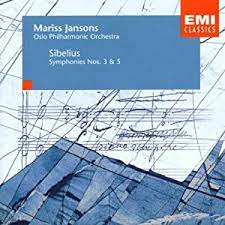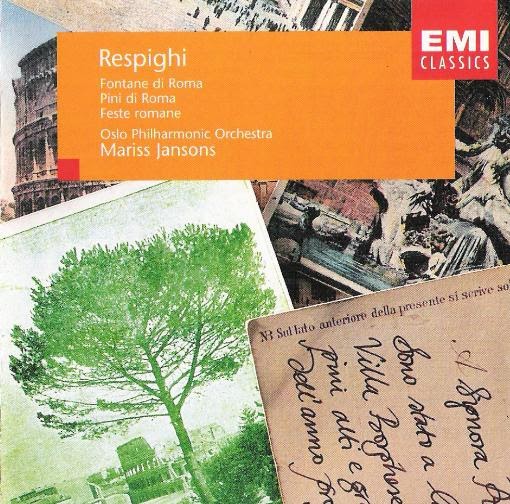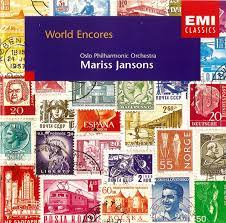Warner Classics release of all twenty one EMI Jansons/Oslo recordings plus five DVDS of selected NRK TV concert broadcast concerts

Sibelius: Symphonies No. 3 & 5
The year 1994 saw the Oslo Philharmonic and Mariss Jansons make two recordings for EMI. The first was devoted to the music of Camille Saint-Saens and was discussed in the Part Six of this assessment, and the Symphonies No. 3 and 5 of Jean Sibelius. This recording was made in August of 1994. The fact that we were recording more Sibelius seemed to us to be a harbinger of a complete Sibelius cycle – counting these two symphonies, we would have recorded four of the seven up to this point. However, we were deep into the contract, and after this recording there remained only two recordings on the docket. While we hoped that we could “go for the cycle”, or go off on what I now consider a tangent, which is what we did, sad to say.
We were nonetheless happy to be recording these symphonies, and we certainly put our best into them. As I mentioned earlier, Jansons loved the music of Sibelius and never seemed to put a foot wrong when it came to this composer. The Fifth Symphony was another staple of the orchestra’s repertoire, and we had recently “played it in” on tour in the spring of 1994, so there was no pressing need to program it for the recording sessions. The Third Symphony was another story, however. Since it was not a regular staple of the orchestra’s repertoire, we played it in a pair of concerts during the week of the recording sessions.
Our recording team of John Fraser and Michael Sheady were back behind the recording console and we really dug in for these sessions. I used the Hingers for both symphonies, although for the Third, I used the two middle Hingers that we bought from John Wyre in 1992 and the 31 inch Light Continental chain. For the Fifth, I used the orchestra’s normal set of Hingers. All were equipped I am glad to say with calfskin heads. It was an experiment which in my opinion turned out well.
The recording sessions went well. As I stated earlier, everyone put their soul into it, and when we were finished, eagerly awaited the results. I was pleased initially when the recording was released. Musically, the results were excellent, and acoustically they were very good. Notice that I made a difference between the musical and acoustic qualities. There is a difference in the sonic presentation between the two symphonies.
The Third is close-miked, but not overpoweringly so. There is a good deal of presence and detail, and this in my opinion gives the music the depth and perspective it needs. Musically, Jansons was at the top of his game. He draws first-rate playing from the orchestra and his tempi are always well-judged. The music flows. It is a pity that this symphony isn’t better known. The opening bars are catchy. I still find myself humming them from time to time.
The Fifth Symphony is also well played and conducted. The acoustic is a little less present than the Third, and this, in my opinion, does the music no favors. I love the Fifth. The first movement reminds me of a living, breathing entity, especially in the transition from the first section to the second section . That should flow like lava, and in our performances it did. Due to the different miking on the recording, one notices the slight lack of presence at these moments. Just a little closer miking would have made quite a difference. Despite that, Jansons and the orchestra give quite a good performance – full of energy and musical integrity. I give this recording an A. It should have been a A+. It would have, if it hadn’t been for the slightly recessed sound in the Fifth.

Respighi: Roman Trilogy
After the Sibelius third and fifth Symphonies were recorded in August of 1994, there were just two recordings left for Jansons and the orchestra to record, and the repertoire was disheartening to us to say the list, Our Sibelius, Honegger and Dvorak recordings were very fine, and we were hoping to get a complete cycle of either the Dvorak or Sibelius symphonies. I see now that the Dvorak would have extended the contract by several discs, but we could have used the last two sets of sessions to complete the Sibelius cycle. But now, the powers-that be went off on a tangent and scheduled us to record two of the Respighi trilogy- Pini di Roma and Fontane di Roma to add to the already recorded Feste romane (which we set down in 1989) in order to sell the recording as a complete Roman Trilogy. These sessions took place in 1995, and the final recording – a sampling of orchestral encores called “World Encores” – was scheduled for 1996, but due to circumstances beyond our control was not set down until 1997. More about that hodgepodge later.
As I said, the Feste romane was recorded back in February 1989 and originally released on disc with music of Ravel and Dukas. I will not discuss this here as I already have shared my assessment in an earlier installment of this blog post. I’ll confine myself to Pini di Roma and Fontane di Roma.
These recording sessions took place in October of 1995, working as usual around a concert series featuring both works. John Fraser and Michael Sheady again made up the recording team, and both concerts and recording sessions proceeded without incident. While I was excited to be part of the recording process, I was becoming less sanguine about the end result. When it was released, my reservations were largely justified. For one thing, I did not care for the Feste romane recording – due mainly to the sound. The performance was good, but let down by a very dry acoustic. I have already gone into this. No, the problem was never musical. All three works received excellent performances, but were let down by the acoustics. In the case of the Pini di Roma and Fontane di Roma it was the slightly recessed miking that worked against the music in the loudest moments. All of these works are blockbusters – parts of these are “pedal-to-the-metal’ and should have been given that treatment. Instead they come off as a bit too refined. Jansons ideas and tempi are just great, and the orchestra plays with committment, but again, A+ for effort and B for sound. I give it a B+, Would that we recorded more Sibelius!
NB: Here is the Pines of the Appian Way, from Pini di Roma. My favorite clip from this recording. Enjoy!

World Encores
After the recording sessions for the Respighi Roman Trilogy, there were no further official recording sessions for EMI until May of 1997. The orchestra had long known that the repertoire for this final recording would be a potpourri of orchestra encores from around the world but a combination of circumstances surrounding Mariss Janson’s health put these sessions off for about thirteen months. In early April, there was a test recording session of all of the repertoire for this album held at Vang Church just outside of Oslo. EMI sent John Fraser, and we ran through the entire list of encores over the course of a four-hour session. Everybody involved was by now intensely dissatisfied with the acoustics of the Konserthus, and this was an attempt o find an alternate venue. Unfortunately, nothing came of it, as a few days later Mariss suffered his near-fatal heart attack near the end of a concert performance of Puccini’s La Boheme.
Happily, he recovered sufficiently by the late fall of 1996 to lead the orchestra in a Far Eastern tour, but any plans to record the encore disc were on indefinite hold.
By the spring of 1997, Mariss and EMI had concluded that Vang Church was not the answer to our acoustical problems, so that was that, and this disc would be recorded in….you guessed it…the Oslo Konserthus! (Modified rapture!) By this time, all of us knew (but weren’t saying out loud) that this was it forthe orchestra’s relationship with EMI. After “World Encores”, they would be recording Mariss Jansons with other orchestras. They were really more interested in him anyway, and it made sense. The recording industry was taking a hit with the backlog of analog recordings of great conductors such as Karajan, Boult, Furtwaengler, Giulini, et.al. It was difficult to choose repertoire that hadn’t been recorded by the so -called giants. So, we would go out with a whimper, rather than a bang.
Recording sessions took place in May of 1997. John Fraser produced, with Michael Sheady again in the recording engineer’s chair. Repertoire included Bernstein’s “Overture to Candide”, Kim’s “Elegy“, Johann Strauss II:” Donner und Blitzen“, Henrik Gades’ “Jalousie Tango“, Elgar’s “Wild Bears“, and others including the Dance from Theodarakis”Zorba the Greek” and the “Intermezzo” from Kodaly’s “Hary Janos.”
For me, the Bernstein and the Strauss and Theodarakis encores were my favorite. A few other pieces from previous recordings were aded after we finished recording the newer material. The sessions went well, and that, as they say, was that. Upon release of the album, I again had mixed feelings. Everything was well played, and the acoustic was pretty good – still a little recessed for my taste, but I felt let down by EMI. And this was due to the hodgepodge we had just released. A poor way to end the EMI contract, I felt and still feel to this day. We could have managed to finish the Sibelius cycle. Now there would have been a legacy! Instead, we played a bunch of musical trifles. I give the orchestra and Jansons an A for effort. Choice of repertoire: C+: overall result: B+
Here is the link to the Finale from Zorba! One of my favorites from the album! Enjoy!
A Postcript:
What might have been
I have said this before – it would have been better to end with a completed Sibelius cycle. Here are links to the Sibelius Symphony No. 3. This was the best of the three discs in this last installment of the assessment. A good way to show what mighthave been.

Recent Comments